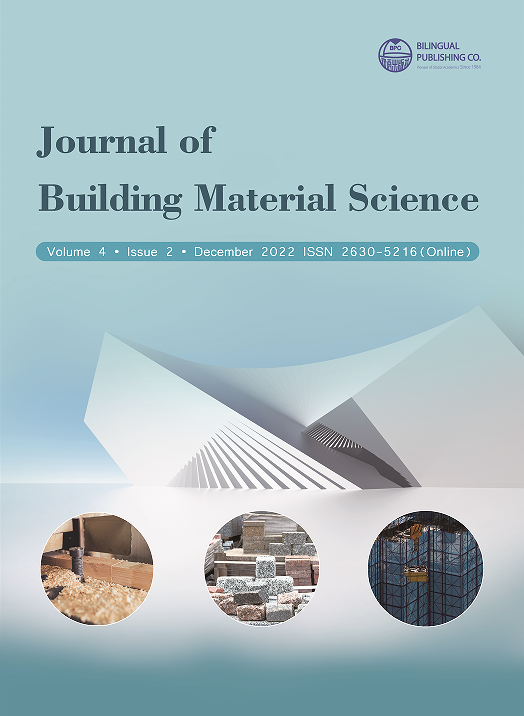
Properties of Sawdust Concrete
DOI:
https://doi.org/10.30564/jbms.v4i2.4818Abstract
This work examined the structural properties of concrete obtained by partially replacing cement with sawdust ash. The sawdust ash which is a pozzolan was obtained by burning sawdust which is a waste product from processing of timber in an open air. The burnt ash was passed through a 150 µm metric sieve to obtain the ash used. Physical and chemical analysis were performed on the ash to verify its suitability as a partial substitute for cement in concrete. Chemical analysis was also carried out on the Ordinary Portland Cement (OPC) sample. Concrete mixes were produced by replacing OPC with 0%, 5%, 10%, 20% and 30% of Sawdust Ash (SDA). Both fresh and hardened properties of the concrete produced were investigated. The chemical investigation on the ash showed that it contained most of the basic compounds found in OPC making it suitable to serve as a partial substitute for OPC in concrete. Investigation on the concrete showed that both the workability and density of the concrete reduce as the SDA content increases. Analysis on the hardened concrete revealed that the compressive strength of the concrete decreases as the ash content increases for the early ages of curing. However, from 21 days curing age upwards, the compressive strength decreases as SDA increases up to 10% of SDA at which the compressive strength rose to a maximum value, and then starts reducing again as the percentage SDA increases. Thus, the SDA concrete gained rapid strength at later ages indicating its pozzolanic activity.
Keywords:
Sawdust ash; Pozzolan; Concrete; Ordinary portland cement; Compressive strengthReferences
[1] Surahyo, A., 2019. Concrete Construction: Practical Problems and Solutions, 2nd ed.; Springer Nature: Switzerland. pp. 1-320.
[2] Heinemann, H.A., Nijland, T.G., 2016. Historic Lime-Binders: An Example of 19th Century Dutch Military Plain Concrete. Materials and Environment (CiTG), Delft University of Technology, The Netherlands.https://www.researchgate.net/publication/289550096
[3] Shetty, M.S., Jain, A.K., 2019. Concrete Technology: Theory and Practice; S. Chand Publishing, New Delhi. pp. 1-350.
[4] ASTM C618-06: Standard Specification for Coal Fly Ash and Raw or Calcined Natural Pozzolan for Use in Concrete. Annual Book of ASTM standards. American Society for Testing and Materials Vol. 04-02.
[5] Neville, A.N., Brooks, J.J., 2010. Concrete Technology, 2nd ed., Pearson Education Limited: England. pp. 1-442.
[6] Newman, J., Choo, B.S., 2003. Advanced Concrete Technology; Constituent Materials, Elsevier Ltd: Great Britain.
[7] Fapohunda, C., Kilani, A., Adigo, B., et al., 2021. A Review of Some Agricultural Wastes in Nigeria for Sustainability in the Production of Structural Concrete. Nigerian Journal of Technological Development. 18(2), 76-87.
[8] Siddique, R., Singh, M., Mehta, S., et al., 2020. Utilization of treated saw dust in concrete as partial replacement of natural sand. Journal of Cleaner Production. 261(10). DOI: https://doi.org/10.1016/j.jclepro.2020.121226
[9] Alabduljabbar, H., Huseien, G.F., Sam, A.R.M., et al., 2020. Engineering Properties of Waste Sawdust-Based Lightweight Alkali-Activated Concrete: Experimental Assessment and Numerical Prediction. Materials. 13(5490), 1-30.DOI: https://doi.org/10.3390/ma13235490
[10] Batool, F., Islam, K., Cakiroglu, C., et al., 2021. Effectiveness of Wood Waste Sawdust to Produce Medium- to Low-Strength Concrete Materials. Journal of Building Engineering. 44. DOI: https://doi.org/10.1016/j.jobe.2021.103237
[11] Hassen, S.A., Hameed, S.A., 2020. Physical and Mechanical Properties of Sawdust Cement Mortar Treated with Hypochlorite. IOP Conference Series: Materials Science and Engineering. 745, 012149. DOI: https://doi.org/10.1088/1757-899X/745/1/012149
[12] El-Nadoury, W.W., 2021. Production of Sustainable Concrete Using Sawdust. Magazine of Civil Engineering. 105(5). DOI: https://doi.org/10.34910/MCE.105.7
[13] Ettu, L.O., Osadebe, N.N., Mbajiorgu, M.S.W., 2013. Suitability of Nigerian Agricultural By-Products as Cement Replacement for Concrete Making. International Journal of Modern Engineering Research (IJMER). 3(2), 1180-1185.
[14] Parande, A.K., Stalin, K., Thangarajan, R.K., et al., 2011. Utilization of Agroresidual Waste in Effective Blending in Portland Cement. International Scholarly Research Network. 2011. DOI: https://doi.org/10.5402/2011/701862
[15] Patel, M., Patel, K., Patel, A., et al., 2016. Study of Sawdust Concrete Properties as Construction Materials. 3rd International Conference on Multidisciplinary Research & Practice. IV(1), 201-205.
[16] Elinwa, A.U., 2021. Mechanical Strengths of Sawdust-Ash-Admixed Gum Arabic Concrete. Journal of Modern Materials. 8(1), 12-29. DOI: https://doi.org/10.21467/jmm.8.1.12-29
[17] Elinwa, A.U., Abdulkadir, S., 2016. Sawdust Ash as an Inhibitor for Reinforcement Corrosion in Concrete. MOJ Civil Engineering. 1(3), 1-5. DOI: https://doi.org/10.15406/mojce.2016.01.00015
[18] Okoroafor, S.U., Ibearugbulam, O.M., Onukwugha, E.R., et al., 2017. Structural Characteristics of Sawdust-Sand-Cement Composite. International Journal of Advancements in Research & Technology. 6(1), 173-180.
[19] BS EN 197-1:2000. Cement: Composition, Specifications and Conformity Criteria for Common Cements. British Standards Institution, London.
[20] BS 882, 1992. Specifications for Aggregates from Natural Sources for Concrete. British Standards Institution, London.
[21] Frata, D., Aguettant, J., Roussel-Smith, L., 2007. Soil Mechanics Laboratory Testing. CRC Press, Taylor & Francis Group: New York.
[22] Jackson, N., Dhir, K.R., 1996. Civil Engineering Materials, 5th ed. Palgrave, China. pp. 106 - 126.
Downloads
How to Cite
Issue
Article Type
License
Copyright © 2022 Onyechere, Ignatius Chigozie

This is an open access article under the Creative Commons Attribution-NonCommercial 4.0 International (CC BY-NC 4.0) License.







 Onyechere, Ignatius Chigozie
Onyechere, Ignatius Chigozie





